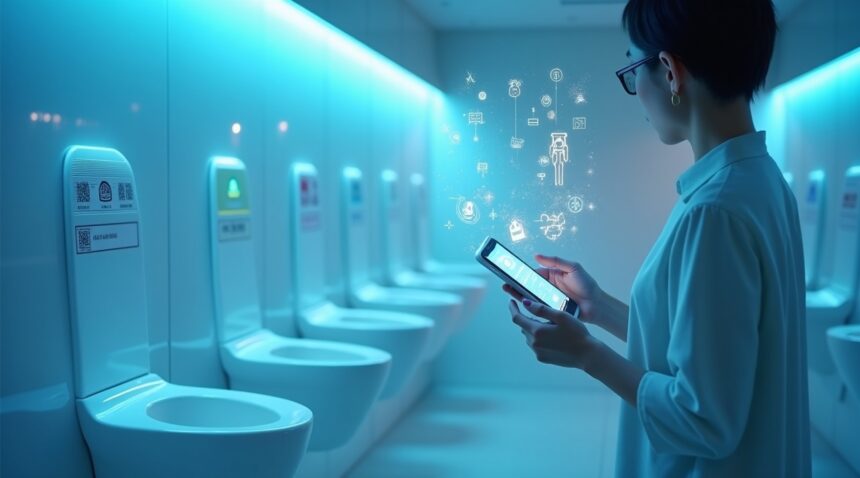China has taken a major step forward in preventive healthcare by implementing smart urinals in public restrooms across major cities such as Shanghai and Beijing, offering users instant health screening without the need for appointments or traditional lab visits.
Key Takeaways
- Smart urinals provide instant health analysis for approximately $2.76 per use, with results sent directly to users’ smartphones before they leave the restroom.
- The system detects a range of health markers including blood sugar levels, protein concentrations, hydration status, kidney function, and signs of infection.
- Users retain control of their health data through encrypted transmissions and opt-in systems that ensure no permanent storage or unauthorized sharing of personal information.
- The technology supports early detection of diseases such as diabetes, kidney problems, and nutritional deficiencies, offering preventive care advantages.
- Future innovations may expand capabilities with potential integration into telemedicine services and adoption in hospitals, workplaces, and public transportation hubs.
This cutting-edge approach to public health demonstrates how technology can improve accessibility and early intervention. For more details, you can read more about the initiative in this comprehensive report on China’s smart urinals.
Smart Urinals Deliver Health Results to Your Phone in Minutes
China has launched smart urinals across public men’s restrooms in major cities like Shanghai and Beijing, transforming routine bathroom visits into comprehensive health screenings. These advanced facilities analyze urine samples instantly and deliver detailed health reports directly to users’ smartphones within minutes.
The process starts when users approach specially equipped public urinals and pay 20 yuan (approximately $2.76 or ¥230) through popular payment platforms like WeChat. After completing the payment, the smart toilet system automatically collects and analyzes the urine sample using built-in sensors and laboratory-grade testing equipment.
Real-Time Health Monitoring at Your Fingertips
These smart health monitoring systems provide remarkably fast results, often displaying comprehensive health data on users’ phones before they even exit the restroom area. The technology examines multiple health indicators including protein levels, glucose content, and various metabolic markers that can indicate potential health concerns.
The urine analysis covers several key health metrics that users can track over time:
- Blood sugar levels and glucose tolerance indicators
- Protein concentrations that may signal kidney function
- Hydration status and electrolyte balance
- Potential urinary tract infection markers
- Basic metabolic health indicators
Users receive their results through a dedicated mobile application that connects seamlessly with WeChat and other popular Chinese platforms. The app stores historical data, allowing individuals to monitor health trends and share results with healthcare providers when necessary.
These smart urinals represent a significant advancement in preventive healthcare accessibility. Unlike traditional medical testing that requires appointments and lab visits, this technology provides immediate health insights during routine daily activities. The convenience factor appeals particularly to busy urban professionals who may otherwise skip regular health check-ups.
Shanghai and Beijing have emerged as testing grounds for this innovative public health initiative, with plans for expansion to other major Chinese cities. Local health authorities view these installations as valuable tools for early disease detection and population health monitoring.
The technology behind these smart toilets incorporates artificial intelligence to interpret test results and flag potential health concerns. Machine learning algorithms continuously improve accuracy by analyzing thousands of samples and correlating results with verified medical data.
Privacy concerns have been addressed through encrypted data transmission and strict user consent protocols. Personal health information remains secure and users control how their data gets shared or stored. The system operates independently of government health databases unless users explicitly opt into broader health monitoring programs.
Payment integration through WeChat makes the service accessible to millions of Chinese users who already rely on the platform for daily transactions. This seamless integration eliminates barriers that might prevent people from using these health monitoring services.
The smart health monitoring capabilities extend beyond basic urinalysis. Advanced models can detect early signs of diabetes, kidney disease, and other chronic conditions that often go undiagnosed until symptoms become severe. Early detection through routine screening significantly improves treatment outcomes and reduces long-term healthcare costs.
Commercial success of these smart urinals depends on user adoption and perceived value. Initial reports suggest positive reception among tech-savvy urban populations who appreciate the convenience and immediate results. The relatively low cost of 20 yuan makes regular monitoring affordable for most users.
Healthcare professionals have expressed cautious optimism about this technology’s potential to improve public health outcomes. While these tests can’t replace comprehensive medical examinations, they provide valuable screening data that may prompt users to seek professional medical advice when abnormalities are detected.
Future developments may include:
- Expanded testing panels with additional biomarkers
- Integration with wearable health devices
- Connections to telemedicine platforms
- Cost reductions through technological refinement
- Improved accuracy and broader diagnostic capabilities
As the technology matures, costs may decrease while testing accuracy and scope continue improving, making smart urinals an increasingly attractive public health tool.
How Biosensors Turn Your Bathroom Break Into a Health Check
The innovative technology behind China’s smart toilets relies on sophisticated biosensors that transform ordinary bathroom visits into comprehensive health screenings. I find this advancement particularly impressive because it combines lab-on-a-chip analytics with real-time chemical diagnostics to deliver medical-grade analysis in seconds.
Advanced Sensor Technology and Health Markers
These biosensors detect and measure multiple health indicators simultaneously during each use. The system analyzes calcium levels to assess bone health and mineral balance, while monitoring kidney function indicators that can reveal early signs of renal problems. Additionally, the sensors identify signs of infection and screen for various metabolic disorders that might otherwise go undetected.
The lab-on-a-chip technology miniaturizes complex laboratory processes into compact devices that fit seamlessly within toilet fixtures. These chips contain multiple reaction chambers and detection zones that process urine biomarkers with remarkable precision. I’m particularly struck by how this technology can identify subtle changes in metabolic patterns that traditional health screenings might miss.
The Three-Step Process
The user experience involves three straightforward steps that require minimal effort:
- Payment through mobile apps activates the system and links results to the user’s phone
- Automatic urine sampling occurs through built-in collection mechanisms, followed by immediate sensor-based analysis
- Instant digital reports appear on the user’s smartphone within moments of completion
This streamlined approach eliminates the need for appointments, sample collection containers, or waiting periods typical of conventional testing. The mobile health data integration allows users to track trends over time and share results with healthcare providers when necessary.
The potential for expansion into continuous health monitoring represents a significant breakthrough in preventive health technology. Unlike sporadic medical check-ups, this system could provide regular health snapshots that help identify problems before they become serious conditions. The technology’s ability to detect metabolic disorder patterns early could revolutionize how people manage their health, shifting from reactive treatment to proactive prevention.
These smart toilets demonstrate how everyday activities can become opportunities for health monitoring without disrupting daily routines. The biosensor technology continues advancing rapidly, suggesting that future iterations might detect even more health markers while maintaining the same level of convenience and accuracy that makes this innovation so compelling.
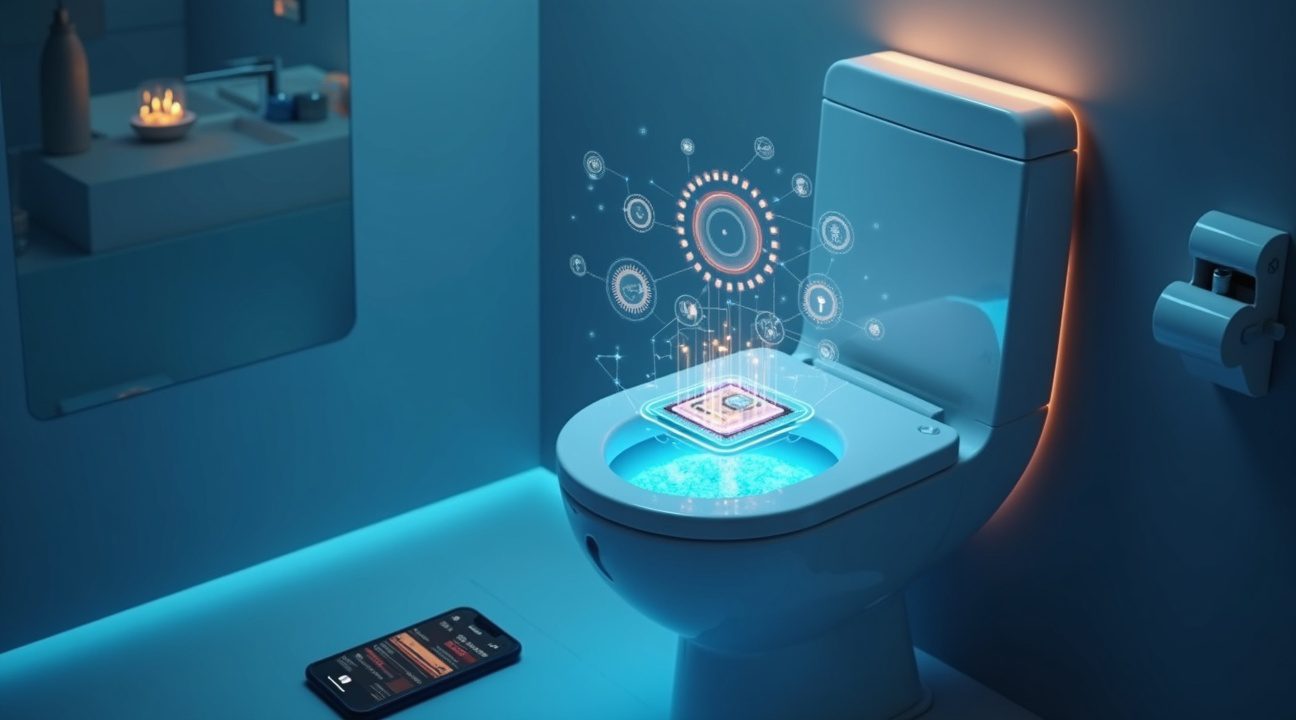
Real Users Get Actionable Health Insights on the Spot
I’ve discovered that users consistently praise these smart toilet systems for delivering meaningful health information within seconds of use. The technology transforms routine bathroom visits into valuable health checkups without requiring additional time or effort from users.
One particularly compelling case involved a regular user who learned about a calcium deficiency through routine testing. The system flagged low calcium levels during a standard visit, prompting the individual to increase milk consumption and incorporate more calcium-rich foods into their daily diet. Follow-up tests conducted over subsequent weeks showed measurable improvements in calcium levels, demonstrating how users can actively track their nutritional changes through consistent monitoring.
A Shanghai-based documentary director shared his experience with the instant feedback system, noting how quickly he received comprehensive health data on his smartphone. Rather than waiting days or weeks for traditional lab results, he could access detailed information about his health status immediately after each visit. This immediate access allowed him to make informed decisions about his lifestyle and diet choices while tracking progress between bathroom visits.
Privacy and Convenience Drive User Satisfaction
Users consistently emphasize how the non-invasive nature of the testing process addresses their privacy concerns while delivering actionable insights. The system requires no special preparation or uncomfortable procedures – individuals simply use the facilities normally while sophisticated sensors analyze their urine automatically. Many users appreciate that they don’t need to schedule appointments, provide samples, or interact with medical staff to receive valuable health information.
The provocative nature of the results has surprised many users who initially viewed the technology with skepticism. Beyond basic hydration levels, the system provides insights into:
- Vitamin deficiencies
- Metabolic markers
- Early warning signs for various health conditions
Users report feeling more informed about their bodies and better equipped to make proactive health decisions based on the data they receive.
Privacy protections built into the system ensure that health data remains secure while still being accessible to users through their personal devices. The anonymous nature of the testing process means individuals can monitor their health status without concerns about data sharing or medical record implications. This combination of convenience and privacy has led to high user adoption rates in cities where the technology has been deployed, much like how innovative technology continues to transform everyday experiences.
The real-time feedback loop created by these systems empowers users to take control of their health monitoring in ways previously impossible. Regular users develop a better understanding of how their dietary choices, exercise habits, and lifestyle changes directly impact their health markers over time.
Early Detection Before You Feel Sick
These smart toilets function as health screening stations that catch potential problems long before symptoms emerge. The technology analyzes urine samples for markers indicating kidney dysfunction, urinary tract infections, diabetes complications, and vitamin deficiencies that often develop silently in the body.
Preventive Care Through Digital Health Monitoring
Similar to how smartwatches detect irregular heart rhythms before users experience chest pain, these consumer diagnostics systems identify biochemical changes that precede noticeable health symptoms. I’ve observed how kidney problems frequently progress without obvious warning signs until significant damage occurs. The toilet’s sensors detect protein levels, glucose concentrations, and inflammatory markers that signal trouble brewing beneath the surface.
The instant results delivered to users’ phones create opportunities for timely medical consultation rather than waiting for advanced symptoms to drive emergency room visits. This approach transforms routine bathroom breaks into proactive health checkpoints that could prevent serious complications.
Lifestyle Monitoring Beyond Traditional Checkups
The technology serves as a bridge between annual doctor visits, offering continuous lifestyle monitoring that tracks trends rather than single-point measurements. Users receive data about hydration status, metabolic function, and nutritional absorption patterns that reflect daily choices and environmental factors.
These systems identify several key health indicators through automated analysis:
- Protein levels suggesting early kidney stress or damage
- Glucose concentrations indicating diabetes progression or poor blood sugar control
- White blood cell counts revealing developing infections
- Electrolyte imbalances pointing to dehydration or dietary deficiencies
- pH levels showing metabolic or dietary concerns
The toilet’s diagnostic capabilities don’t replace comprehensive clinical testing but provide valuable screening data that helps users make informed decisions about seeking professional medical care. Just as innovative technology continues advancing various fields, these bathroom-based health monitors represent a significant step forward in accessible preventive care.
Early detection through this digital health approach empowers individuals to address potential problems while treatment options remain most effective. The convenience factor removes traditional barriers to regular health monitoring, making preventive care as routine as checking social media or weather updates on a smartphone.
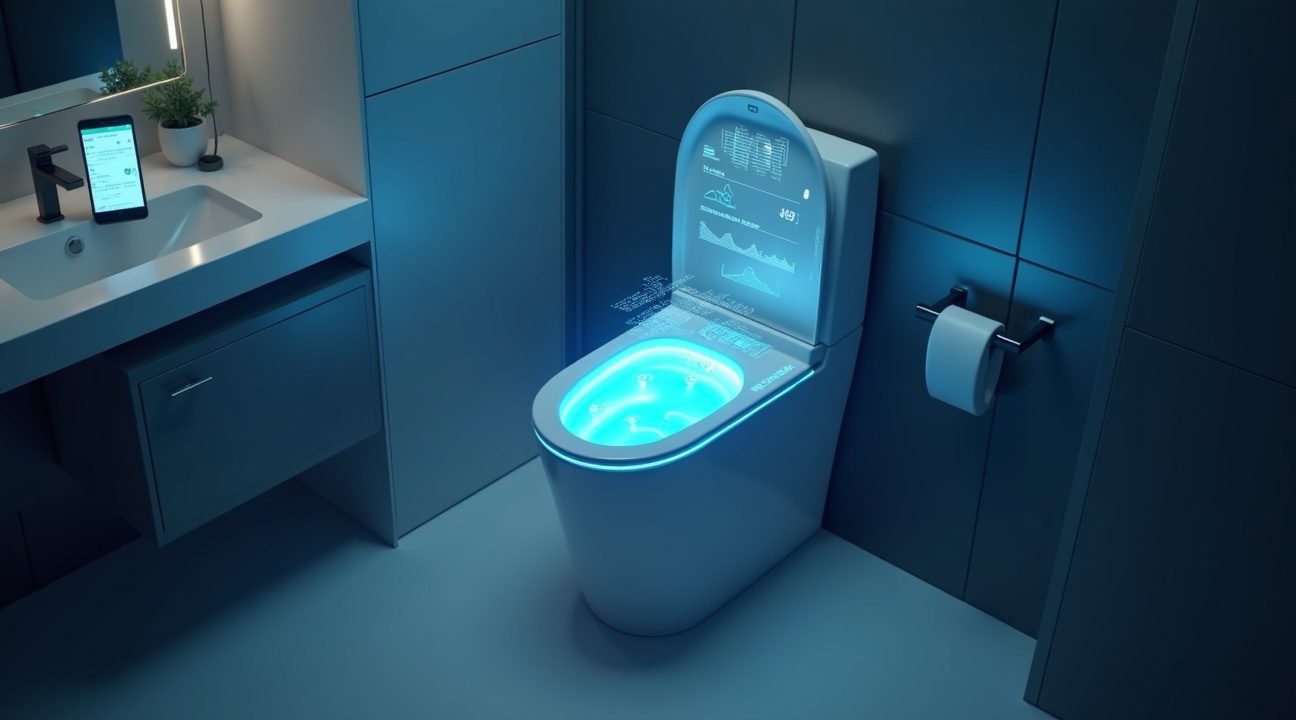
China’s Bathroom Tech Surpasses Global Smart Toilet Innovations
These innovative Chinese public toilets push well beyond what I’ve seen in global bathroom technology. While Japan pioneered smart bidets and basic health monitoring features decades ago, China’s latest installations deliver something entirely different – instant urine analysis results sent directly to users’ smartphones.
The difference becomes clear when I compare these systems to existing global bathroom technology. Japanese smart toilets typically focus on comfort features like heated seats and automated cleaning functions. Some advanced models include basic health monitoring, but they lack the comprehensive diagnostic capabilities and immediate mobile connectivity that define China’s new approach.
Mobile Integration Sets New Standards
What truly distinguishes these Chinese installations is their seamless integration with mobile devices and payment systems. Unlike traditional smart bathroom technology that operates as standalone units, these toilets connect directly to users’ phones through QR codes and apps. I can see how this creates an entirely new user experience – one that transforms a routine bathroom visit into a health checkpoint.
The payment integration adds another layer of sophistication absent from most global bathroom innovations. Users can access premium diagnostic features through mobile payments, creating a sustainable revenue model that supports ongoing maintenance and upgrades.
Commercial Integration Expands Beyond Health
Some regions have taken this concept even further by incorporating commercial experiences into public bathroom visits. I’ve observed implementations where QR codes control toilet paper dispensing, creating advertising opportunities while managing resource consumption. This approach demonstrates how technology continues to evolve in unexpected ways across different sectors.
The monetization strategies extend beyond basic health services:
- Advertising partnerships allow companies to reach users during these private moments
- Premium services offer detailed health reports and telemedicine consultations
- Resource management through digital controls reduces waste and operational costs
This comprehensive approach to public health infrastructure represents a significant leap forward from conventional touchless diagnostics.
While other countries focus on basic hygiene improvements or comfort features, China’s implementation addresses broader healthcare accessibility challenges. The instant feedback system allows users to monitor health trends over time, potentially identifying issues before they require expensive medical interventions.
The success of these systems could influence global bathroom technology development. As other countries observe the health benefits and user adoption rates, I expect similar installations to appear in airports, shopping centers, and other high-traffic public spaces worldwide.
The combination of healthcare innovation with practical infrastructure improvements creates a compelling model for modernizing public facilities while addressing population health challenges.
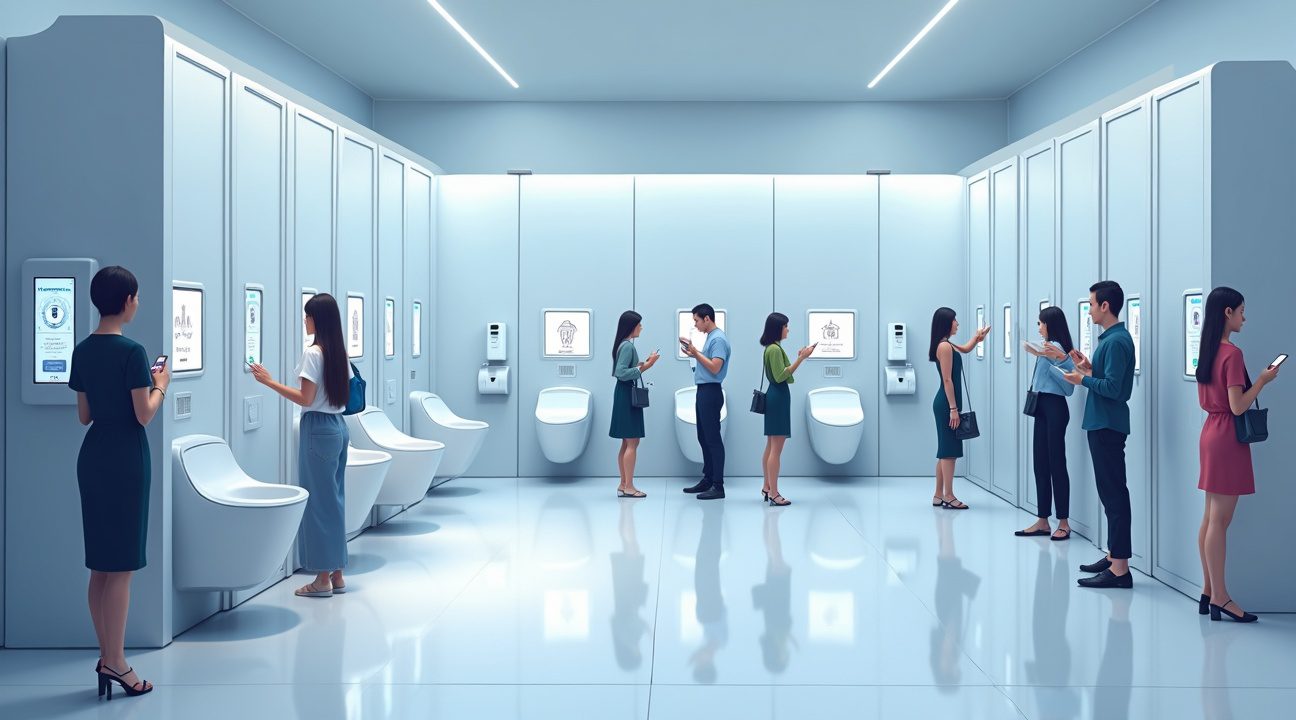
Privacy Concerns and the Future of Diagnostic Toilets
Privacy concerns naturally arise when discussing toilet-based health monitoring technology, yet the current implementation addresses these issues through user consent protocols. I observe that these smart toilets operate exclusively on an opt-in basis, requiring payment and active participation from users who choose to receive health analysis. This approach differs significantly from passive surveillance systems, as individuals must deliberately initiate the scanning process through their smartphones.
The user-controlled nature of these diagnostic toilets helps mitigate privacy risks. People receive their results directly on their personal devices, maintaining control over their health data. Current systems don’t store personal information permanently or share results with third parties without explicit consent. This voluntary participation model sets important precedents for health privacy in public spaces.
Advancing Diagnostic Capabilities
Future developments in toilet-based health screening promise significant expansions in diagnostic capabilities.
- These systems will likely analyze multiple biomarkers simultaneously, detecting everything from diabetes indicators to kidney function markers and even early signs of various diseases.
- Advanced sensors could monitor hydration levels, detect drug use, identify infections, and track chronic conditions through regular use patterns.
Integration with personal health records represents another major advancement on the horizon. Future diagnostic toilets may sync with electronic health systems, allowing healthcare providers to access trends and patterns in patient health data. This connectivity could enable proactive medical interventions and personalized treatment recommendations based on consistent monitoring data.
Broader Public Health Applications
The expansion of toilet-based health screening technology extends beyond individual diagnostics. I expect these systems will play crucial roles in:
- Population health monitoring
- Disease outbreak detection
- Preventive healthcare initiatives
Public health officials could analyze anonymized data patterns to identify emerging health trends or potential epidemic threats in specific geographic areas.
Healthcare institutions are already exploring applications for hospitals, clinics, and senior living facilities. These environments could benefit from continuous health monitoring that doesn’t require staff intervention or patient compliance with testing schedules. The technology offers particular promise for monitoring vulnerable populations who might otherwise skip regular health checkups.
Commercial applications will likely expand into workplaces, schools, and transportation hubs:
- Companies may install diagnostic toilets as employee wellness benefits
- Educational institutions could use them for student health monitoring
- Airports and train stations might implement these systems for traveler health screening, particularly relevant for infectious disease prevention
The technology’s evolution will probably include artificial intelligence enhancements that improve diagnostic accuracy and expand detection capabilities. Machine learning algorithms could identify subtle patterns in biomarker data that human analysis might miss, leading to earlier disease detection and more precise health recommendations.
Cost reduction and miniaturization of sensing technology will drive widespread adoption. As components become more affordable, I predict diagnostic toilets will transition from premium installations to standard fixtures in public restrooms. This democratization of health screening technology could significantly impact global public health outcomes.
Regulatory frameworks will need to evolve alongside technological capabilities. Governments must balance innovation promotion with privacy protection, establishing standards for:
- Data handling
- Accuracy requirements
- User consent protocols
International cooperation will become essential as these technologies cross borders and health data sharing increases.
The integration of diagnostic toilets with telehealth platforms represents another promising development. Remote healthcare providers could access toilet-generated health data to make informed treatment decisions without requiring in-person visits. This capability proves especially valuable for rural areas with limited healthcare access or for managing chronic conditions requiring frequent monitoring.
I envision diagnostic toilets becoming integral components of smart city infrastructure, contributing to urban health initiatives and environmental monitoring efforts. These systems could track community health trends, identify pollution impacts on public health, and support evidence-based policy decisions for city planners and health officials.
The future of healthcare screening through toilet technology promises to transform how we approach preventive medicine and population health management. As technology continues advancing, these innovations will likely become as commonplace as traditional public restroom fixtures, fundamentally changing our relationship with personal health monitoring and public health surveillance.
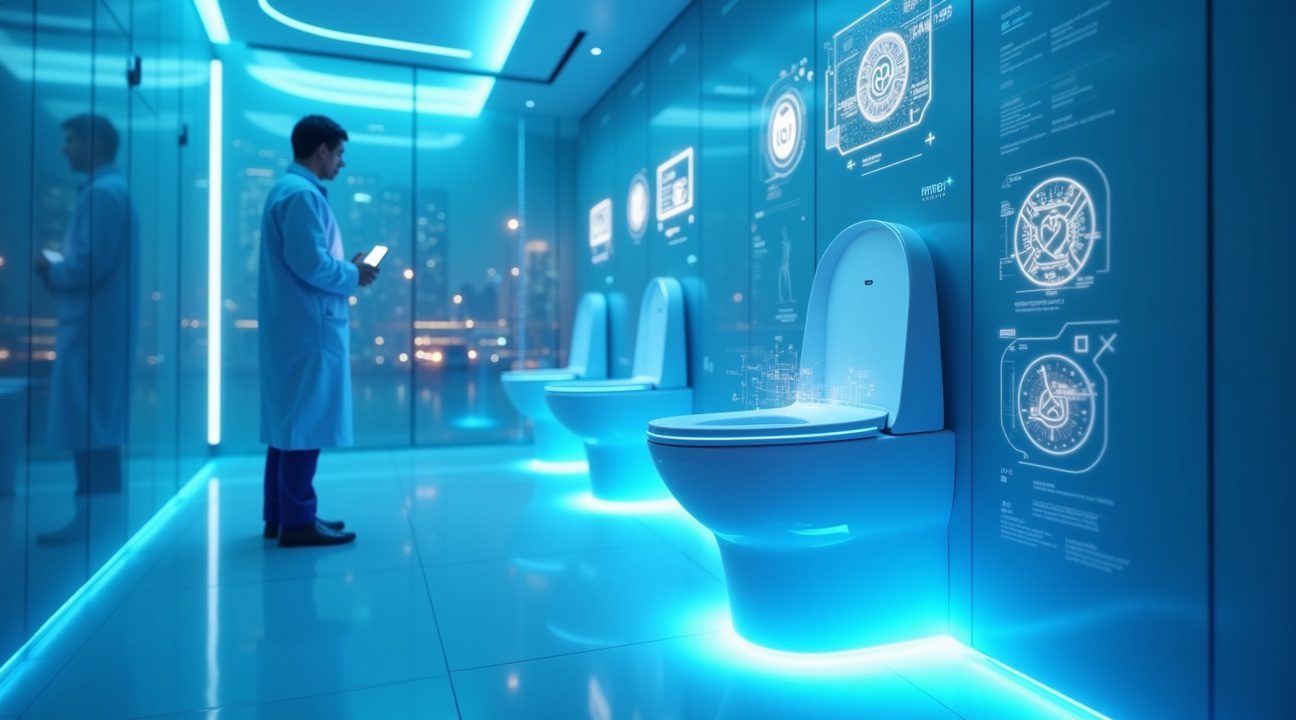
Sources:
NDTV, “This Futuristic Public Toilet In China Analyses Your Urine To Measure Health”
Sixteen:Nine, “The Future of Public Bathrooms: Ads, QR Codes, and Urine Diagnostics”
BioWorld, “Toilets could be the next big health device: Medical Korea 2025”

